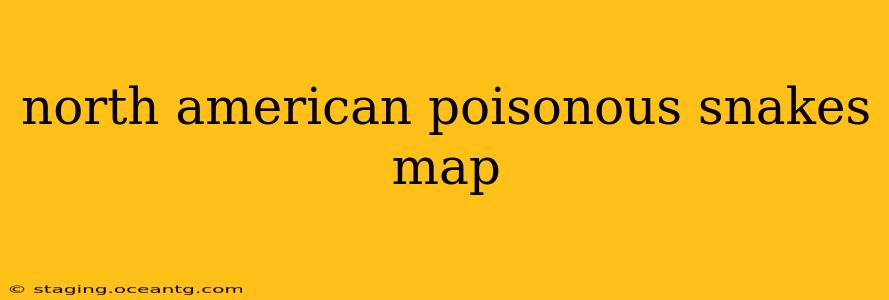North America is home to a diverse range of snakes, some of which are venomous and pose a significant threat to humans and pets. Understanding their geographic distribution is crucial for safety and responsible wildlife interaction. This guide provides a comprehensive overview of poisonous snakes in North America, incorporating information gleaned from various herpetological sources and addressing frequently asked questions. While a precise map showing the exact range of every venomous snake species is difficult to create due to the dynamic nature of their habitats and ongoing research, this guide will use general geographic regions to illustrate their distribution.
Understanding Venomous Snake Distribution:
It's crucial to remember that snake distributions aren't static. Environmental changes, habitat loss, and even human intervention can shift their ranges over time. This map provides a general guideline, and encountering a venomous snake outside of its typically mapped range is possible. Always exercise caution when in areas known to have venomous snakes.
(Note: A detailed interactive map would be ideal here, but unfortunately, I cannot create visual elements directly. Consider using an online mapping tool to create a visual representation based on the information below.)
Geographic Regions and Their Venomous Snakes:
-
Southeastern United States: This region boasts the highest diversity of venomous snakes, including various species of rattlesnakes (Eastern Diamondback, Timber, Canebrake, pygmy), copperheads, cottonmouths (water moccasins), and coral snakes.
-
Southwestern United States and Mexico: This arid and semi-arid region is home to several rattlesnake species, including the Mojave rattlesnake (known for its potent neurotoxic venom), the Western Diamondback, and various sidewinders. This region also sees the presence of certain coral snake species.
-
Central and Western United States: The distribution of venomous snakes here is less dense compared to the southeast and southwest. However, rattlesnakes, particularly prairie rattlesnakes and Great Basin rattlesnakes, are found in various parts of this region, alongside some less common species.
-
Northeastern United States and Canada: The number of venomous species is significantly lower in this region. The timber rattlesnake and copperhead are the most likely venomous species encountered here.
-
Pacific Northwest: The venomous snake population in this region is limited. While rattlesnakes can occasionally be found in specific areas, their presence is much less common than in other parts of North America.
Frequently Asked Questions about North American Poisonous Snakes
Many people have questions about identifying and dealing with poisonous snakes. Let's address some of the most common ones:
What are the most common venomous snakes in North America?
The most widespread venomous snakes across North America include various rattlesnake species (characterized by their distinctive rattles), copperheads (with hourglass-shaped markings), cottonmouths (with dark bands and a wide head), and coral snakes (with bright, banded coloration).
How can I tell the difference between a venomous and non-venomous snake?
There is no single foolproof way to distinguish venomous from non-venomous snakes. Relying solely on physical characteristics can be unreliable. Some key features to consider, but not solely rely on, include:
-
Triangular Head: Venomous snakes often have a triangular head shape due to their venom glands. However, some non-venomous snakes can mimic this shape.
-
Pupil Shape: Many venomous snakes have elliptical pupils, while non-venomous snakes typically have round pupils. Again, this is not a reliable indicator.
-
Presence of Rattles: Rattlesnakes are easily identified by the presence of rattles.
-
Heat-Sensing Pits: Some pit vipers (copperheads, cottonmouths, rattlesnakes) have heat-sensing pits between their eyes and nostrils.
The best way to identify a snake is through careful observation and ideally, consultation with a herpetologist or wildlife expert.
What should I do if I see a venomous snake?
The safest course of action is to avoid all contact and maintain a safe distance. Do not attempt to handle or kill the snake. Slowly and calmly back away from the area. If bitten, seek immediate medical attention.
What is the best treatment for a venomous snake bite?
Do not attempt home remedies. Seek immediate medical attention. Knowing the type of snake involved, if possible (take a picture from a safe distance), will greatly assist medical professionals in providing the appropriate antivenom. Remain calm, keep the bitten area still and below the heart, and monitor for any allergic reactions.
How can I prevent snake bites?
Prevention is key! Follow these tips:
-
Be Aware of Your Surroundings: Pay close attention to where you place your hands and feet when hiking or working outdoors, especially in areas known to have snakes.
-
Wear Protective Clothing: When in snake habitat, wear long pants and sturdy boots.
-
Keep a Safe Distance: Maintain a safe distance from snakes; never approach or try to handle them.
-
Secure Your Property: Keep your yard clear of debris, rocks, and tall grass, where snakes might hide.
This comprehensive guide provides a foundation for understanding the distribution and characteristics of venomous snakes in North America. Remember that safety and responsible wildlife observation are paramount when venturing into areas where venomous snakes may be present. Consult with local wildlife experts for more specific information regarding your area.
